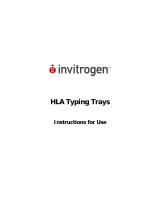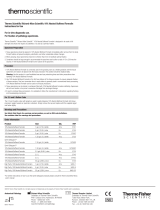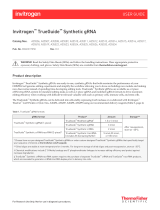
HLA Antisera
Instructions for Use

1
For In Vitro Diagnostic Use
HLA Antisera
Instructions for Use
For In Vitro Diagnostic Use
The Invitrogen™ HLA Antisera are manufactured for the identification and definition of
Histocompatibility Antigens and are for use in HLA typing.
The microlymphocytotoxicity assay uses lymphocytes as the target. Viable cells are easily
extracted from peripheral blood, lymph nodes, spleen, etc. This serologic assay measures cell
death by the activation of complement (rabbit) in the presence of specific antigen-antibody
combinations. The antibody-antigen-complement reaction is measured by viewing the test
microscopically at 150 x magnification with phase contrast illumination and a vital stain such as
Eosin Y or Propidium Iodide. Dead cells (which possess the antigen detected by the specific
antisera) will absorb the dye and exhibit an appropriate color change. Negative cells (those
lacking the antigen detected by the specific antisera) remain viable and exclude the dye.
The Invitrogen™ HLA Antisera are for use in the microlymphocytotoxicity assay for definition of
HLA antigens. They are specific for the HLA antigen(s) listed on the vial label. Each vial contains
a specified volume of frozen or freeze-dried antisera containing 0.1% sodium azide as a
preservative. These HLA Antisera are in vitro diagnostic reagents for professional use only and
reactivity must be confirmed by the user with the specific complement that will be used in testing.
CAUTION: HANDLE AS IF CAPABLE OF TRANSMITTING INFECTIOUS DISEASE
Plasma and/or serum from which this product was derived has been tested and found to be
negative for HBsAg, HIV-1, and HCV by an FDA approved method of assay. However, no test
method offers complete assurance that HIV, hepatitis B virus, or other infectious agents are
absent. They should therefore be handled as potentially infectious human blood specimens.
In this manual:
Section Description Page
1. Kit Components 2
2. Material, Reagents, and Equipment not Supplied 2
3. Sample Requirements 3
4. Lymphocyte Suspension Preparation 3
5. B and T Cell Separation 4
6. Microlymphocytotoxicity Test 4
7. Interpretation 6
8. Performance Standards 6
9. Troubleshooting 6
10. Limitations and Precautions 7

2
For In Vitro Diagnostic Use
1 Kit Components:
Description Quantity Storage
1.1 Freeze-Dried Antisera containing
0.1% sodium azide as a
preservative, 1 ml/vial
1 -20° C or colder in a
NON-FROST FREE
FREEZER
OR Frozen Antisera containing 0.1%
sodium azide as a preservative, 1
ml/vial
1 -55° C or colder in a
NON-FROST FREE
FREEZER
1.2 Certificate of Analysis 1 ----------
2 Material, Reagents, and Equipment not Supplied:
2.1 Bench top centrifuge
2.2 Light Microscope
2.3 Inverted Phase Contrast or Inverted Fluorescent Microscope
2.4 Pasteur pipettes 6 and 9 inch
2.5 Microtiter syringes 50 µl, 100 µl, 250 µl
2.6 12x75 mm and 17x100 mm test tubes
2.7 Hemacytometer
2.8 Glass Cover slide 2” x 3”
2.9 Magnetic beads, Invitrogen™ Dynabeads® HLA Cell Prep I (product code 219.02)
and Invitrogen™ Dynabeads® HLA Cell Prep II (product code 219.03)
2.10 Micro Tissue Culture Plates, Invitrogen™ product code 71000100
2.11 5% Dextran
2.12 Ficoll-Hypaque solution
2.13 RPMI-1640 media with HEPES buffer and Pen/Strep added
2.14 Hanks Balanced Salt Solution (HBSS)
2.15 Trypan Blue
2.16 Eosin Y solution or CFDA
2.17 12-37% Neutralized Formalin pH 7.0±0.2 or Propidium iodide in quenching solution
2.18 Mineral Oil Light
2.19 Pooled Human Serum (PHS), Invitrogen™ product code 34005100
2.20 Rabbit Complement, Invitrogen™ product code 31021100
2.21 HLA Positive Control Serum, Invitrogen™ product code 1145005

3
For In Vitro Diagnostic Use
3 Sample Requirements:
3.1 A lymphocyte suspension is prepared from 10ml whole blood collected into a
heparinized, ACD, or sodium citrate vacutainer tube. Cell concentration is adjusted
to 2-3 x 106 cells/ml. The lymphocyte suspension must be prepared within 48 hours
of collection of whole blood for optimum viability. The suspension is to be stored at
room temperature until use.
3.2 A viability of greater than 80% without excessive contamination of non-lymphocyte
cells is essential for optimum performance of HLA antisera.
3.3 Granulocyte contamination or a high background of non-viable lymphocytes may
cause a false positive reaction.
3.4 Platelet contamination may result in incomplete lysing of lymphocytes causing a
false negative reaction.
3.5 Lymphocytes may be prepared according to the following procedure or additional
methods which are listed in the ASHI Laboratory Procedure Manual.3
4 Lymphocyte Suspension Preparation:
4.1 Collect 10 ml of whole blood into a heparinized, ACD, or sodium citrate vacutainer
tube. (EDTA has been found to be an unacceptable anticoagulant.3) Store the
sample at room temperature until use.
4.2 Centrifuge the blood for 10 minutes at 700-900 x g to obtain buffy coat.
4.2.1 This can also be done by use of an aggregating agent such as 5%
Dextran as follows:
4.2.1.1 Mix 2 ml of 5% Dextran with 10 ml of whole blood and allow red
cells to sediment at 37°C for 15 minutes.
4.3 Using a Pasteur pipette, carefully remove the buffy coat (approximately 2 ml) and
transfer to a clean 17x100 mm tube containing 5 ml of HBSS. Mix well.
4.4 Dispense 4 ml of Ficoll-Hypaque (FH) gradient solution (22°C) into a clean 17x100
mm tube. Carefully layer the buffy coat suspension over the FH gradient solution.
4.5 Centrifuge for 20 minutes at 700 x g. After centrifugation the mononuclear cells can
be found as a narrow band at the interface between the plasma/diluent and
gradient solution.
4.6 Aspirate all of the mononuclear cell layer and transfer to a 17x100 mm tube. Dilute
with 4 ml of HBSS.
4.7 Centrifuge for 10 minutes at 600 x g. Remove supernatant, gently resuspend cell
pellet, add 4 ml HBSS, and centrifuge for 10 minutes at 600 x g.
4.8 Remove supernatant and resuspend cell pellet in 1 ml of RPMI-1640 with 20% PHS.
4.9 Examine the cell suspension on a hemacytometer. Assess purity and perform a cell
count. Adjust the cell concentration to 2-3 x 106 cells/ml.

4
For In Vitro Diagnostic Use
4.10 Perform a viability test as follows.
4.10.1 Add one drop of Trypan Blue and one drop of cell suspension in a
clean tube, then mix well.
4.10.2 Incubate the mixture at room temperature for 15 min.
4.10.3 Examine the cell viability on a hemacytometer. Viable cells have
intact cell membranes and thus appear smooth; they are able to
exclude the Trypan blue and therefore will be colorless.Non-viable
cells do not have intact cell membranes and thus do not appear
smooth; they are unable to exclude the Trypan blue and therefore
will be colored.
4.10.4 The lymphocyte suspensions are ready for use in the Class I
Microlymphocytotoxicity Test using the dye exclusion method.
5 B and T Cell Separation:
5.1 Nylon Wool Procedure:
B and T lymphocytes are easily separated by use of the nylon wool technique. B
cells and macrophages have the property of adhering to nylon wool, whereas T cells
do not. Refer to the 4th Edition ASHI Laboratory Manual; Section 1.A.6 “Nylon Wool
Separation of T and B Lymphocytes” for B and T cell separation procedure.
5.2 Bead Procedure:
5.2.1 Magnetic beads are available from several manufacturers.
5.2.2 HLA Cell Prep I and HLA Cell Prep II (Invitrogen™) have been
tested for use with all Class I & II antisera. Refer to
manufacturers Instructions for Use.
5.2.3 Bead purified B cells and T cells are generally prestained using
CFDA (Carboxyfluorescein Diacetate) or Ethidium Bromide.
6 Microlymphocytotoxicity Test:
6.1 If Freeze-Dried sera are used, reconstitute sera as follows.
6.1.1 Reconstitute the serum with a 1 ml of sterile distilled water.
NOTE: Accurate measurement of the distilled water is critical.
6.1.2 Dispense reconstituted antisera directly onto test trays (see
Section 6.4) or into smaller units for future use.
6.1.3 Aliquots can be frozen and should be stored at or below -55°C.
Reconfirm reactivity prior to use.
6.2 If Frozen sera are used, thaw the sera as follows.
6.2.1 Thaw a vial of serum in 37°C water bath and remove immediately
upon total thawing.

5
For In Vitro Diagnostic Use
6.2.2 Dispense thawed antisera directly onto test trays (see Section 6.4)
or into smaller units for future use.
6.2.3 Aliquots can be frozen and should be stored at or below -55°C.
Reconfirm reactivity prior to use.
6.3 Prepare a lymphocyte suspension of at least 80% viability without excessive
contamination of non-lymphocyte cells.
6.4 Using a pasteur pipette or automatic tray oiler, add mineral oil to each well on the
test trays.
6.5 Using a 50 µl syringe, add 1 µl of appropriate Invitrogen™ HLA antisera to the test
well, below the mineral oil.
6.6 Using a 50 µl syringe, add 1 µl of lymphocyte suspension (approximately 3,000
lymphocytes) to the top each test well, being careful not to touch the antisera.
Examine each well to ensure the lymphocyte suspension and antiserum have mixed.
6.7 Incubate the microtrays at room temperature (22°C ± 3°C).
Class I (dye exclusion) 30 min
Class I (fluorescence) 30 min
Class II (fluorescence) 45 min
6.8 Using a 50 µl or 250 µl syringe, add 5 µl of rabbit complement to the test wells,
being careful not to touch the antisera/lymphocyte mixture with the syringe tips.
6.9 Incubate the trays at room temperature (22°C ± 3°C).
Class I (dye exclusion) 60 min
Class I (fluorescence) 50 min
Class II (fluorescence) 60 min
6.10 Using a 100 µl syringe or equivalent, add 2 µl of filtered 5% aqueous Eosin Y to
each test well and incubate at room temperature (22°C ± 3°C) for 3-5 minutes. Be
careful not to touch the antisera/lymphocyte mixture with the syringe tips. Omit
this step if you are using a Fluorescein based assay.
6.11 Using a 250 µl syringe, add 5 µl of filtered neutralized formalin to each test well,
being careful not to touch the antisera/lymphocyte mixture. Omit this step in the
Fluorescein based assays.
6.11.1 Fluorescein based assays: Add 5 µl of propidium iodide in
quenching solution to each of the test wells, being careful not to
touch the antisera/lymphocyte mixture.
6.12 Place a cover slide over the tray and let plates stand at room temperature for 15
minutes to allow the lymphocytes to settle.
6.12.1 Trays stained with Eosin Y can be read after one hour or the
following day.
6.12.2 Trays stained with Fluorescein can be read after 30 minutes or
the following day.

6
For In Vitro Diagnostic Use
Note: Reading a fluorescein-stained tray after 36 hours may result in increased false
positives.
6.13 Observe the test microscopically at 150 x magnification under phase contrast
illumination.
7 Interpretation:
7.1 Dead cells (those possessing the antigen) absorb the dye, appear enlarged and
darkened and show distinct nuclear detail. Viable cells (those lacking the antigen),
exclude the dye, appear slightly brighter and smaller in size as compared to dead
cells.
7.2 Alternatively, fluorescently labeled viable cells are green and nonviable cells are red.
7.3 After correcting for percent dead cells in negative control wells, the test is graded as
follows:
% Dead Cells Score Interpretation
0-10 1 Negative
11-20 2 Doubtful Negative
21-50 4 Weak Positive
51-80 6 Positive
81-100 8 Strong Positive
-- 0 Unreadable
8 Performance Standards:
8.1 Specificity and Sensitivity
8.1.1 Invitrogen™ HLA Antisera have been extensively tested by
internal and external screening against a well qualified
lymphocyte panel containing various ethnic groups. The dilutions
and specificity of each Invitrogen™ HLA Antisera have been
determined by titration (using serial dilutions) against lymphocyte
suspensions with known HLA types. Each serum is used at its
optimal dilution to achieve the highest reaction value while
maintaining specificity. Most sera have R values of 0.8 or better.
Information contained in the Certificate of Analysis provided for
each lot of trays will assist in explaining unexpected reactions.
8.1.2 Invitrogen™ HLA Positive Control Serum (rabbit anti-human
lymphocyte serum) should be included on each test tray.
8.1.3 Invitrogen™ Pooled Human Serum (PHS) should be used as
Negative Control Serum on each test tray. This serum has been
screened and found to be negative for lymphocytotoxic antibodies
against T cells and B cells by the standard microlymphocytotoxic
assays.
9 Troubleshooting:
9.1 High background or false positives may be attributed to:

7
For In Vitro Diagnostic Use
9.1.1 Sample has low cell viability or damaged cells. Remove dead cells
before adding to the typing trays, or prepare another cell
suspension.
9.1.2 Sample is contaminated with granulocyte or other non-
lymphocytes. Remove non-lymphocyte cells before adding to the
trays, or prepare another cell suspension.
9.1.3 Reagents containing toxic substances or that have pH outside the
normal physiologic range may cause cell damage. Be sure
reagents used have been properly tested.
9.1.4 Complement is too strong or has high toxicity level.
9.1.5 Incubation time is too long. Be sure to follow this Instruction for
Use closely for incubation time based on cell isolation techniques.
9.1.6 Incomplete reaction or false positives can be caused by cell or
serum carry-over.
9.2 Weak reaction or false negatives may be attributed to:
9.2.1 Sample is too concentrated. Be sure the cell concentration is
adjusted to 2-3 x 106 cells/ml.
9.2.2 Sample is contaminated with platelets.
9.2.3 Sera or reagents have pH changed due to exposure to CO2 or
bacterial contamination. Use fresh reagents and check pH before
use.
9.2.4 Complement is too weak or inactivated prior to addition to the
trays.
9.2.5 Incubation temperature is improper. Low temperatures cause
slower reaction, whereas high temperatures cause degradation of
thermolabile components. Be sure the incubation temperature is
22°C ± 3°C.
9.2.6 Incubation time is too short. Be sure to follow this Instruction for
Use closely for incubation time based on cell isolation techniques.
10 Limitations and Precautions:
10.1 Rabbit complement is a critical reagent in the lymphocytotoxicity test procedure and
can vary from lot to lot. Unsatisfactory complement will result in weak or false
negative reactions or high background in the negative control. The activity of rabbit
complement can be determined by testing with appropriate positive and negative
controls as well as with known lymphocytes and antisera.
10.2 Invitrogen™ HLA-ABC and DR Complement have been individually tested to meet
minimum titers and background toxicity (see catalog and/or complement package
insert). However, it is advisable that samples of each new lot of complement be
tested in parallel with an existing or known lot. A suitable rabbit complement
should exhibit a strength reading of 8 with the positive control and most of the

8
For In Vitro Diagnostic Use
positive reactions. It should exhibit a strength reading of 1 with the negative
control and most of the negative wells.
10.3 HLA testing using the Invitrogen™ HLA Antisera must be performed in the presence
of a qualified Director, Technical Supervisor and/or General Supervisor following
accepted laboratory standards. We must emphasize that these products are for
professional use only.
10.4 Samples should be stored at room temperature until use and EDTA should not be
used as an anticoagulant for sample collection.
References
1. DeWolf, W.C., Cannady, W.G., and Yunis E.J. (1978), The Major Histocompatibility
Complex, Clinical Diagnosis and Management by Laboratory Methods, 2, 1353 (16th
Edition) Ed. by Henry, J.B., New York: WB Saunders & Company.
2. Cannady, W.G., DeWolf, W.C., Williams, R.M., and Yunis, E.J. (1978), Laboratory Methods
in Transplantation Immunity, Progress in Clinical Pathology, 7, 239, Ed. by Stefanini, M.
New York: Grune and Stratton, Inc.
3. Hahn, A. et al. (eds.) (2000) ASHI Laboratory Manual, 4th Edition, American Society for
Histocompatibility and Immunogenetics, PO Box 15840, Lenexa, KS 66215.
4. Walford, R.L., Galligher, R., Sjaarda, J.R. (1964), Serologic Typing of Human Lymphocytes
with Immune Serum Obtained After Homografting, Science, 144, 868.
5. Tsuji, K., Aizawa, M., Sasazuki, T. (1992) HLA 1991, Proceedings of the Eleventh
International Histocompatibility Workshop and Conference, Oxford University Press.
PR005
Revision 03
Print 10/06

European Representative:
Invitrogen Ltd.
11 Bassendale Road
Croft Business Park
Bromborough, Wirral
CH62 3QL, U.K.
Tel: 44 151 346 1234
Invitrogen Corporation
9099 North Deerbrook Trail
Brown Deer, Wisconsin 53223 USA
Tel: (800) 955-6288
Fax: (800) 331-2286
www.invitrogen.com
9
For In Vitro Diagnostic Use

For country-specific contact information visit our website at
www.invitrogen.com
Invitrogen Corporation
9099 N. Deerbrook Trail
Brown Deer, WI 53223 USA
Tel. 1-800-955-6288
Fax 1-800-331-2286
Email: [email protected]
/












